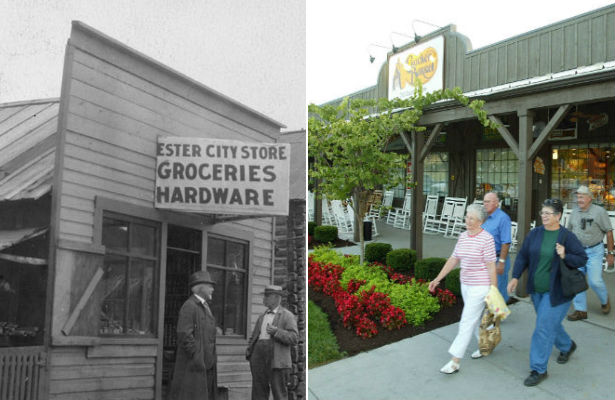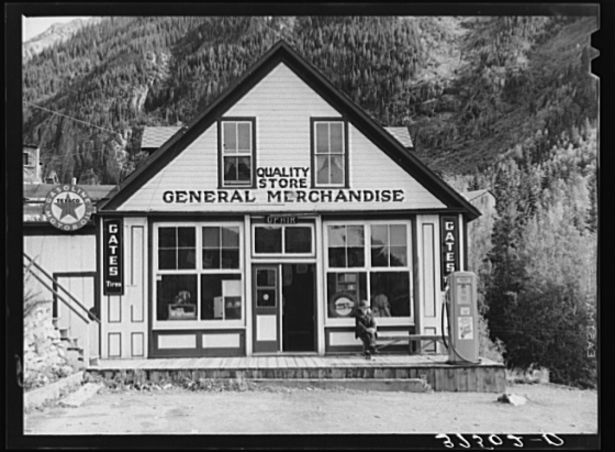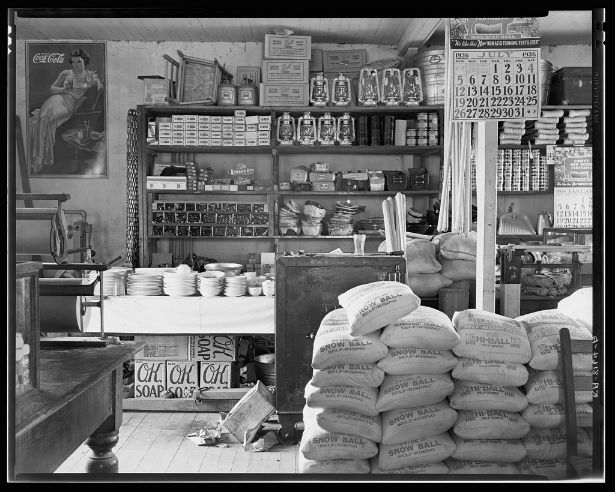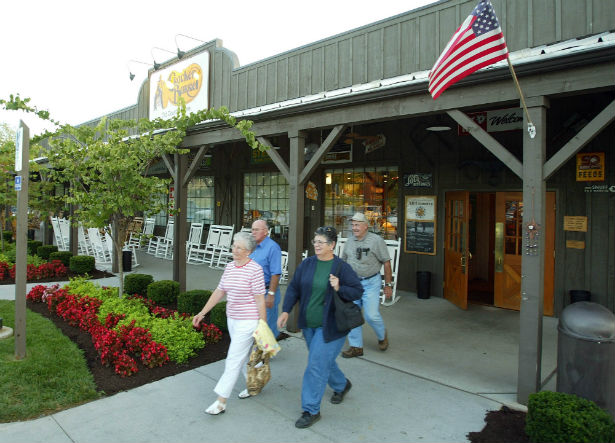Are Cracker Barrel Decorations Authentic
The coincidental dining chain uses thousands of real antiques and preserves a genuine part of U.S. culture.

Library of Congress/AP
Cracker Barrel is today'due south American history museum. Some of the restaurant's visitors get a kick out of its sometime timey decor. Others would rather eat their pancakes without staring upward at former hula hoops and deer heads. Either way, if you've always eaten at a Cracker Butt, you know there are antiques everywhere. Maybe y'all think they're fake. Just the company says they're not. And they're not but kitsch, either. In fact, in their own way, they're quite sophisticated.
The significance of Cracker Barrel's design is a lot easier to sympathize if you think virtually its main reference signal: the 19th- and early-20th-century general store. For over a century, a large number of Americans living in remote areas got most of the stuff they endemic from these small local shops.

Ophir, Colorado, 1940 (Russell Lee/Library of Congress)
In many cases, the stores replaced the 18th century peddler -- a man who carried several dozen pounds of pots or fabric or coffee around the countryside in a cart. Often, a settlement got its general shop when a peddler decided he was ill of wandering around and decided to pitch camp in a particular identify. Many country stores started in small, unpainted, windowless buildings and were improved by their owners over time. Every bit towns developed, they built elaborate facades over the humble original structures.
The general store was frequently cramped, warm, and muddied. The floors were rarely cleaned and tended to get caked with boot mud, soap shavings, nut shells, and whatever else patrons might be ownership or eating. Dried meat hung from the rafters, and colorful advertisements from merchants spruced up bare walls.
In the Northeast, about of the stores had fireplaces or pot-bellied stoves; when it got common cold, there'd be a fire going. (Southern general stores ofttimes had porches in lieu of the stoves.) Some of the owners as well served as town postmaster. Others hosted itinerant wholesalers called "drummers" who traveled the region request store owners to buy an unusual fabric or new kind of broom. More than oft, they succeeded in drinking a lot of complimentary whiskey and telling stories to the assembled residents about whatever large city they'd come up from.
All these attractions basically guaranteed that everyone in town would pass through in a given week, from the local drunk to the elderly widow. Knowing this was expert for concern, owners tried to become them to stay. A lot of the stores had crackers for patrons to snack on while they were hanging out. They were served in a barrel, the same way they were shipped. (Most of the packaging we use today didn't be then.)

General store interior, Moundville, Alabama, 1936 (Walker Evans/Library of Congress)
Cracker Butt picked up on this thought -- the blimp store with a homey vibe -- and branded it. Every time the chain opens a new eating house today, a few hundred old feed lot signs, carriage wheels, pitchforks, and then on send from company headquarters to Florida or Maine or Massachusetts, where they are mounted on the wall alongside only tangentially rustic items like blimp and mounted deer heads, abandoned family photographs, and motorboat motors.
The antiques, according to the company, are existent ones. They come up from beyond the U.S. to the Cracker Barrel Decor Warehouse in Lebanon, Tennessee. The visitor has a mock eating place that it uses to plan the decor of every single location; designers accommodate the elements for each new store in a way that looks right, make a program (with photographs) for where the objects should become, and send it off with those objects to the new location.
The visitor competes with other restaurant bondage, similar Applebees and TGI Fridays, which also use existent antiques in their restaurants. The New York Times reported in 2002 that the restaurants' demand for old objects had grown so much that American antique dealers were struggling to source them.
In the end these items add up to an approximation of the full general store of 100 years ago. The elements don't really obey any kind of historical social club, or whatsoever geographical one. The stores' peaked facade, reaching above the roof of the edifice, is a classic design chemical element of Northern land stores. The front end porch, with its rocking chairs, would more likely accept been found in the South. Taken together, all these elements indicate "general store" to the average American.

John Russell/AP
The ahistorical appropriation of period children's toys, or farm equipment, seems to brand a lot of people uncomfortable -- much like, say, new tract housing in a faux Federal style. The era of the butter churn, we think, was not really the era of the boob tube. Many would debate that throwing a bunch of unrelated objects together is the definition of "poor taste."
However, for a long time, unlike parts of the land really did live in different eras. It turns out women in rural Tennessee did habitually hand-churn their own butter at a time when many suburban and big-city Americans were ownership theirs out of the dairy case at the grocery -- and spreading it on white bread to consume in forepart of a color TV. And as technological advances spread unevenly throughout the country, some households wound up with both a butter churn and a color TV.
The general store itself is a groovy illustration of the uneven pace of change. While many big American cities were able to support their own section stores by the cease of the 19th century -- the get-go, Macy'due south, evolved out of a dry goods store in New York around 1860 -- tiny general stores selling a whole diversity of stuff still existed in parts of the U.Due south. until the middle of the 20th century. (See the dates on the photos above.)
Equally travel and communications technology has sped upwardly and proliferated, fourth dimension has "sped up" likewise, in regions of the country that were one time remote. Today'south cultural and technological gaps don't seem so severe. Sure, at that place are differences between New York City and rural Tennessee, simply the disparities are far fewer than they were even 10 years ago, thanks to increasingly (though not completely) fifty-fifty Internet access.
With this in mind, the array of stuff on Cracker Barrel's walls seems less haphazard and more like a genuine record of U.Southward. history. There are no wall labels, simply for diners who accept the time to really expect at the objects around them, these places brand pretty good museums.
Source: https://www.theatlantic.com/national/archive/2013/03/cracker-barrels-oddly-authentic-version-of-american-history/272826/
Posted by: almondmysinsiging.blogspot.com

0 Response to "Are Cracker Barrel Decorations Authentic"
Post a Comment